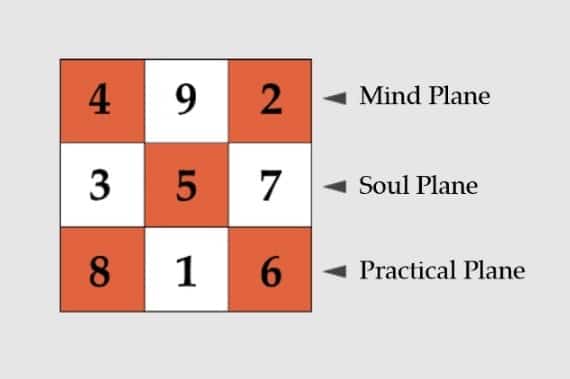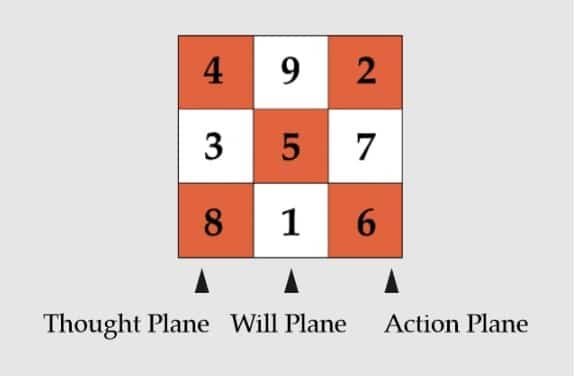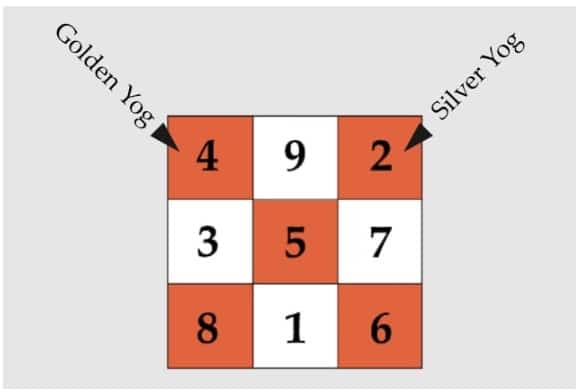
The Complete Guide to Lo Shu Grid Planes: Mental, Emotional, Practical & More Explained
The Lo Shu Grid, is a powerful tool for understanding human characteristics and destiny. By analyzing the arrangement of numbers based on one’s date of birth, the grid provides insights into the intellectual, emotional, and practical aspects of life. The Lo Shu Grid is divided into rows and columns, with each number occupying a square, reflecting different life aspects such as wealth, intellect, and emotions.
One of the most significant aspects of the Lo Shu Grid is the existence of 8 Lo Shu Grid Planes, representing different dimensions of human experience and characteristics. These planes are horizontal, vertical, and diagonal lines formed by specific numbers within the grid. Each plane holds a unique influence, determining how an individual navigates through life in terms of intellect, emotion, practicality, and more.
In this comprehensive guide, we will delve into the 8 planes of the Lo Shu Grid, exploring their deeper meanings, how they impact an individual’s life, and what happens when these planes are balanced or imbalanced. We’ll explore the horizontal planes, then move to the vertical planes, and finally, the diagonal planes.
The 3 Horizontal Lo Shu Grid Planes

1. Mental Plane or Mind Plane
- Numbers: 4, 9, 2 (Top Row)
- Meaning: The first row of numbers 4, 9, and 2 forms the Mental Plane, also referred to as the Mind Plane. This plane represents a person’s intellectual capacity, cognitive abilities, and analytical thinking.
- Individuals with all three numbers in this plane are blessed with sharp intellect, clarity of thought, and a rational approach to life. They are logical thinkers and can analyze situations effectively, leading to well-informed decisions.
- Complete Mental Plane: A complete mental plane (with all numbers 4, 9, and 2 present) indicates an individual who possesses a strong memory, is quick in comprehension and is methodical in their thought process. These individuals can balance emotions with logic, making them decisive and rational.
- Incomplete Mental Plane: If one or more of these numbers are missing, the mental plane is considered incomplete, and the individual might struggle with cognitive tasks. A lack of one of these numbers may result in impulsive decisions, poor memory, or difficulties in concentrating. For instance, missing the number 4 could indicate issues with organizational skills, while the absence of 9 might lead to poor judgment in critical situations.
2. Emotional Plane or Soul Plane
- Numbers: 3, 5, 7 (Middle Row)
- Meaning: The second horizontal row, consisting of numbers 3, 5, and 7, forms the Emotional Plane, also known as the Soul Plane. This plane governs a person’s emotional depth, sensitivity, and ability to empathize with others. It is linked to intuition, feelings, and the heart’s instinctual reactions.
- Balanced Emotional Plane: When all three numbers (3, 5, and 7) are present, the individual is emotionally balanced and empathetic. They can easily relate to others and tend to make decisions based on a combination of logic and emotion. They are usually nurturing, compassionate, and capable of understanding others’ needs.
- Excessive Emotion: An excess of certain numbers on this plane can lead to heightened emotions. For instance, too many 5’s can result in instability, while an abundance of 3’s might cause frequent quarrels or arguments. Interestingly, multiple 7’s are considered auspicious, representing wisdom and introspection.
- Imbalanced Emotional Plane: If any of these numbers are missing, the emotional plane becomes weak, leading to potential difficulties in processing emotions. An individual might struggle with expressing feelings, experience emotional detachment, or be overly sensitive, causing conflicts in relationships.
3. Practical or Material Plane
- Numbers: 8, 1, 6 (Bottom Row)
- Meaning: The third and final horizontal row consists of the numbers 8, 1, and 6, forming the Practical Plane or Material Plane. This plane represents one’s practical abilities, prosperity, and material success. It governs a person’s capacity to handle day-to-day responsibilities, achieve financial success, and build a solid material foundation.
- Complete Practical Plane: A complete practical plane signifies an individual who is grounded, organized, and resourceful. They have the ability to manage their wealth effectively and are usually successful in material pursuits. These individuals are pragmatic, efficient, and capable of turning ideas into reality.
- Incomplete Practical Plane: If any of these numbers are missing, the person may struggle with material success or experience difficulties in managing their wealth. For example, the absence of 8 might lead to missed opportunities for financial growth, while missing 6 could indicate challenges in achieving material stability.
- Excessive Material Focus: If the numbers in the practical plane dominate and the emotional or mental planes are weak, it suggests a person who is highly focused on material success but lacks emotional depth or intellectual clarity. This imbalance can lead to arrogance, egotism, or an excessive preoccupation with wealth.
The 3 Vertical Lo Shu Grid Planes

Vertical planes in the Lo Shu Grid focus on different aspects of thinking, willpower, and action. These planes represent how thoughts, intentions, and actions align in an individual’s life.
1. Thought Plane
- Numbers: 4, 3, 8 (First Vertical Column)
- Meaning: The first vertical column, formed by the numbers 4, 3, and 8, is known as the Thought Plane. This plane reveals an individual’s ability to conceive ideas and transform them into reality.
- Balanced Thought Plane: Individuals with a complete thought plane are innovative thinkers who can generate creative ideas and put them into practice. They are reflective and are capable of making well-thought-out decisions.
- Imbalanced Thought Plane: When the numbers in this plane are incomplete, the person may struggle with impulsivity or poor decision-making. They may come up with ideas but lack the discipline or focus to implement them successfully.
2. Will Plane
- Numbers: 9, 5, 1 (Middle Vertical Column)
- Meaning: The second vertical column, made up of the numbers 9, 5, and 1, forms the Will Plane. This plane represents determination, inner strength, and perseverance.
- Balanced Will Plane: Individuals with a balanced will plane exhibit strong willpower and persistence. They are determined to achieve their goals and are willing to work hard to succeed. This plane also signifies resilience, enabling the individual to overcome obstacles and challenges.
- Imbalanced Will Plane: An incomplete will plane indicates a lack of motivation or determination. Such individuals may struggle with commitment, often giving up when faced with difficulties. They may have grand ambitions but lack the resolve to see things through.
3. Action Plane
- Numbers: 2, 7, 6 (Last Vertical Column)
Significance: This plane reflects a person’s ability to act on their thoughts and intentions. It governs one’s decisiveness, execution skills, and commitment to achieving tangible results.
Balanced Action Plane: A complete action plane indicates that an individual is decisive and action-oriented. They are able to follow through on their plans and are committed to achieving tangible results. These individuals don’t just dream or strategize; they take real steps to make their ambitions a reality.
Imbalanced Action Plane: An incomplete action plane points to procrastination, indecisiveness, or a tendency to leave tasks unfinished. Individuals with a weak action plane may have great ideas but often fail to act on them, leading to missed opportunities and incomplete projects. The absence of number 2 can indicate hesitation in decision-making, missing 7 may reduce self-confidence in execution, and missing 6 can suggest an inability to handle material responsibilities.
The 2 Diagonal Lo Shu Grid Planes

Diagonal planes in the Lo Shu Grid represent a combination of spiritual, material, and intellectual energies that create special yogas (auspicious alignments) within the grid.
1 .Golden Yog (Raj Yog)
Numbers: 4, 5, 6 (Diagonal from Top Left to Bottom Right)
Significance: This diagonal plane is known as the Golden Yog or Raj Yog. It is one of the most auspicious alignments in the Lo Shu Grid and is believed to bring immense fortune, fame, and success.
Impact: Individuals with the Golden Yog are often successful in their endeavors, achieving both material wealth and personal recognition. They are natural leaders, often rising to prominent positions in society due to their intellect, determination, and practical abilities. This yog ensures a balanced approach, where intelligence (4), communication and adaptability (5), and material success (6) work harmoniously.
Imbalanced Raj Yog: If any number in this alignment is missing, the individual may struggle to reach the highest potential of success. Missing 4 can result in a lack of structured thinking, missing 5 can lead to poor adaptability, and missing 6 might affect material gains.
2. Silver Yog (Rajat Yog)
Numbers: 2, 5, 8 (Diagonal from Top Right to Bottom Left)
Significance: This diagonal plane is known as the Silver Yog or Rajat Yog. It is associated with financial prosperity, property gains, and stability in material life. However, it comes with certain challenges and fluctuations.
Impact: Individuals with the Silver Yog are likely to accumulate wealth and properties, but they may experience ups and downs in their financial journey. This yog signifies both fortune and instability, requiring individuals to manage their resources carefully to avoid losses. The presence of number 2 brings cooperation, 5 ensures adaptability, and 8 brings financial discipline.
Imbalanced Rajat Yog: If any number is missing, financial growth may face roadblocks. Missing 2 can result in poor partnerships and collaboration, missing 5 may reduce adaptability in financial matters, and missing 8 might create instability in wealth accumulation.
Interpreting the Lo Shu Grid: A Step-by-Step Guide
Identify the Numbers Present and Missing
Begin by writing down your date of birth and placing the numbers in the respective positions within the 3×3 Lo Shu Grid. Analyze which numbers are present and which ones are missing.Analyze the Horizontal Planes (Mental, Emotional, Practical)
- A complete mental plane suggests strong intellect and clarity.
- A balanced emotional plane indicates emotional intelligence and empathy.
- A strong practical plane suggests financial stability and discipline.
Analyze the Vertical Planes (Thought, Will, Action)
- A balanced thought plane indicates creativity and structured thinking.
- A strong will plane signifies persistence and determination.
- A well-developed action plane ensures execution and accomplishment.
Examine the Diagonal Planes (Golden Yog, Silver Yog)
- Having Raj Yog can bring immense success and stability.
- The presence of Rajat Yog suggests financial prosperity, with necessary caution.
Understand the Missing Numbers and Their Remedies
If numbers are missing, they can create challenges in specific areas of life. However, through numerology remedies, Feng Shui adjustments, and conscious efforts, imbalances can be mitigated.
Balancing the Lo Shu Grid Planes: Remedies and Enhancements
When a plane is incomplete or imbalanced, several remedies can be applied to restore balance:
For Missing Mental Plane Numbers (4, 9, 2)
- Strengthen logical reasoning skills through puzzles and brain exercises.
- Read and engage in analytical discussions.
- Meditate to enhance focus and clarity.
For Missing Emotional Plane Numbers (3, 5, 7)
- Practice mindfulness and emotional intelligence techniques.
- Engage in creative activities like music, writing, or painting.
- Strengthen personal relationships through better communication.
For Missing Practical Plane Numbers (8, 1, 6)
- Develop financial literacy and structured wealth management.
- Enhance discipline through routines and goal setting.
- Seek mentors who can guide in career and material success.
For Missing Thought Plane Numbers (4, 3, 8)
- Engage in visualization exercises to enhance creative thinking.
- Strengthen decision-making by practicing structured approaches.
For Missing Will Plane Numbers (9, 5, 1)
- Develop resilience through goal setting and tracking progress.
- Read books or listen to motivational content.
For Missing Action Plane Numbers (2, 7, 6)
- Focus on taking small actions daily to improve execution skills.
- Work on self-discipline and accountability.
For Missing Golden Yog (4, 5, 6) or Silver Yog (2, 5, 8)
- Strengthen financial management and risk assessment.
- Follow ethical business and personal finance practices.
Practical Applications of the Lo Shu Grid
Self-Discovery & Personal Growth
Understanding one’s strengths and weaknesses enables self-improvement and better decision-making.Career & Business Insights
Entrepreneurs and professionals use the Lo Shu Grid to align career paths with inherent strengths.Relationship Compatibility
The emotional plane provides insights into how individuals connect with others in relationships.Wealth & Financial Success
The practical and diagonal planes help assess financial potential and opportunities.Spiritual Growth & Inner Peace
The spiritual aspects of the Lo Shu Grid guide individuals toward balance and fulfillment.
Conclusion
The 8 planes of the Lo Shu Grid provide a profound framework for understanding human behavior, strengths, and life paths. By analyzing these planes, we can uncover hidden aspects of our personality and gain insights into areas requiring growth and improvement. Whether you are looking for career success, emotional balance, financial stability, or spiritual growth, the Lo Shu Grid serves as a timeless guide toward a well-balanced life.
You may like to read: Lo Shu Grid Missing Numbers Remedies
You may like to read: Repeated Numbers in Lo Shu Grid – Impact and Remedies.
You may like to read: Mastering Name Numerology: Pythagorean and Chaldean Systems Explained.
You may like to read: Mobile Numerology – Unlocking the Mysteries of Mobile Numbers: A Comprehensive Guide.
You may like to read: Numerology Calculator – Exploring Life Path, Soul Urge, and Destiny Numbers.
Author
Rajesh Shethia is an experienced Consultant specializing in providing personalized readings and remedies for various life challenges, including Career, Relationships, Finance, and Physical and Emotional Health. His expertise spans multiple disciplines including Astrology, Numerology, Vastu, and Chakra Balancing, enabling him to offer holistic solutions tailored to individual needs. Clients can contact him for Online Consultations or visit his store in Bangalore for an in-person session. To learn more about the effectiveness of his guidance, one can see the Box2Joy Google Profile page and explore customer reviews. Google Map link for our store location - https://maps.app.goo.gl/8mQfJBVYw45zDGZm9 Online Consultation Chat Link - wa.me/+918880666664


Comments (4)
[…] You may like to read: The Complete Guide to Lo Shu Grid Planes: Mental, Emotional, Practical & More Explained. […]
Sir very nice details sir thanks
Benefitted with the given details!! Can refer your study while we stuck reading any Loshu grid . Thnx for the amazing stuff .
Thank you for the wonderful feedback.